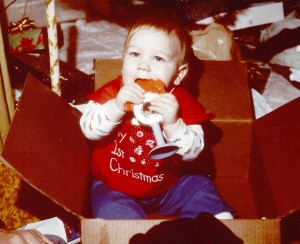The Appeal of the Empty Box
 It’s that time of year again—when people spend time and money seeking the perfect gift for young children, imagining the delight in those children’s eyes as they open the gift and immediately immerse themselves in playing with the new toy, only to find the real fascination is with the box the toy came in. What’s up with that?
It’s that time of year again—when people spend time and money seeking the perfect gift for young children, imagining the delight in those children’s eyes as they open the gift and immediately immerse themselves in playing with the new toy, only to find the real fascination is with the box the toy came in. What’s up with that?
I read about a recent study that looked at how an adult interacts with a child over a new toy can determine the level of creativity the child displays with that toy. In one scenario, the adult performed the traditional “teacher” role, showing the child how to use a toy that beeped and lit up if a particular sequence of button pushing was performed—“Look what happens when I do this!” In another scenario, the adult played more of a guided muse for the child—“I wonder what will happen if we push this button?” When turned loose with the new toy, the children in the first group did pretty much what they were taught to do. In the second group, the children poked and prodded and discovered cool things that the box did that the adult had not showed them.
Compare the toys of today with the toys of pre-electronic age. In the “olden” days, if a doll talked, it only “said” the words a child put into it. Even the earliest “talking” dolls only said “Mama” and left the rest to the child. If a train moved along a track, it was because the child pulled or pushed it—and often on an imaginary track. If a xylophone made music, it was because the child hit the bars and created songs of his own making.
Today’s dolls “do” everything shy of washing dishes. (Let me know when that model comes out, and I’ll buy myself one of those!) The “conversations” are nothing more than monologues dreamed up by the manufacturer. Trains move along prescribed paths, and make their own “choo choo” sounds. Musical instruments—which may still respond in the old-fashioned way with a given pitch for a given note—will now play everything from Mozart to Madonna at the touch of a button.
These new-fangled toys are indeed mesmerizing, but passively so. “Mesmerizing” does not necessarily equal “engaging.” “Mesmerize” conjures up images of blank, hypnotic stares. “Engage” conjures up a more active image of pulling strings, pushing buttons, and—gasp—using the imagination.
Years ago, I gave my young son a short stick—a slightly bent branch with a bump or two on it and asked him how many different things this stick could “be.” Somewhere I have a scrap of paper with the 20 or 30 different ideas that six-year-old came up with. It was a fascinating window into his mind, and perhaps a hint of the engineer he would one day become. That question and that stick provided many more worlds of entertainment possibilities than if I’d merely handed him a toy with a pre-programmed set of things a child could do with it—or, more specifically, things it would do while the child sat and watched.
Engaging in pretend play is a developmental milestone that typically comes into being the second year of a child’s life. It starts as simple imitation, but grows into wonderfully imaginative scenarios and conversations. To watch a child in pretend play is to see a little window into her brain, watching wheels and gears turning, and brain cells connecting.
It’s those connections that are built that turn children and adults into problem solvers. How often do we hear “think outside of the box” as a means to finding new solutions to tough problems? The child who has freely explored the world beyond the box (or maybe the worlds inside an empty box) is more likely to call on those explorations to find those yet-undiscovered but potentially powerful answers to life’s challenges.
I’m not necessarily advocating doing away with all electronic, “let me do it for you” toys. Used judiciously they can provide entertainment and education along the way. Just don’t throw the box away—let’s give the child at least as much time with the empty box as the gizmo inside. If we’re lucky, he or she will take us along for the imagination ride.
Perhaps we, as adults, would benefit from a few hours of playing with an empty box, too!
It went ZIP when it moved, and POP when it stopped,
And WHIRRR when it stood still.
I never knew just what it was
And I guess I never will!
—Tom Paxton, “The Marvelous Toy”
© Melissa Clark Vickers 2013 Text and Image
Back to Home Page